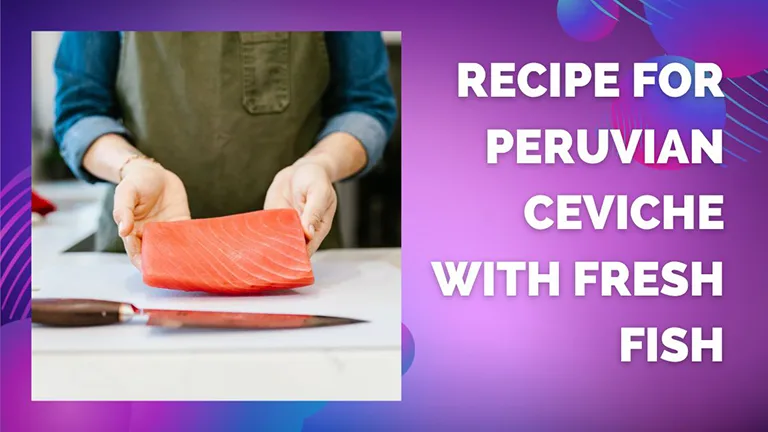In this article, we will guide you on how to make the recipe for Peruvian ceviche with fresh fish and enjoy this explosion of exotic flavors! Peru, with its rich history and vibrant culture, offers a gastronomy as diverse as it is enchanting. Among this country’s culinary treasures, ceviche occupies pride of place. This simple yet refined marinated fish dish reflects the soul of Peruvian cuisine, where fresh ingredients are king. Peruvian ceviche with fresh fish is more than a recipe: it’s a taste experience that transports your senses to the heart of South America. In this article, we invite you to discover the authentic recipe for this exquisite dish, as well as the tips and variations that will enable you to master it perfectly.
Ingredients to the Recipe for Peruvian Ceviche with Fresh Fish
Peruvian ceviche is a delicious, refreshing dish that showcases the freshness of fish. To prepare this tasty dish, you’ll need the following fresh ingredients:
- 500g fresh fish (such as sea bass, sea bream, or halibut), cut into 1-2 cm cubes.
- 1 large red onion thinly sliced.
- 1-2 chili peppers (such as aji Amarillo) seeded and finely chopped.
- juice of 8-10 fresh limes.
- 1 tablespoon fresh coriander finely chopped.
- Salt and pepper to taste.
- 1-2 tablespoons tiger’s milk (optional).
- a mixture of lime juice, fish, onion, chili, and coriander.
- 1 sweet potato, cooked, peeled, and sliced (to serve).
- 1 ear of corn cooked and sliced (to serve).
- A few lettuce leaves (to serve)
What are the preparation steps?
First, in a bowl, cut the very fresh fish fillets into small pieces, then combine the diced fish with the lime juice, chili, salt, and pepper. Marinate in the fridge for 15-20 minutes, or until the fish turns opaque.
Then add the onions and chopped coriander and mix gently. Arrange the lettuce leaves, sweet potato, and corn on the plates. Add the ceviche and drizzle with tiger’s milk if using.
Finally, garnish with additional cilantro if desired and serve immediately.
Peruvian ceviche should be prepared and eaten fresh to get the best flavor and texture. It’s a simple yet sophisticated dish, ideal for a summer meal or an elegant appetizer.
What variations are possible?
Other fish that can be used
Other fish can be used to prepare a delicious Peruvian ceviche. You can opt for alternatives such as salmon, sea bream, tuna, or sole.
Make sure you choose fresh, quality fish for a tasty ceviche. Each type of fish will bring its own unique flavor to the dish, allowing you to create interesting variations.
Feel free to experiment with different types of fish to discover your favorite combination of Peruvian ceviche.
Adding extra fruit or vegetables
To add a touch of freshness and color to your Peruvian ceviche, consider adding additional fruits or vegetables, such as avocado, mango, tomatoes, cucumbers, or peppers.
As well as adding a crunchy texture, these ingredients bring a deliciously sweet flavor that marries perfectly with the marinated fish.
Putting ceviche revisited into practice
Here are two recipes for ceviche revisited that offer unique, exotic flavors to delight your guests. The first blends Asian flavors with scallops, while the second brings a tropical sweetness with mango and salmon. These variations on traditional ceviche offer a refreshingly original culinary experience.
1. Ceviche with scallops and ginger
Ingredients:
- 500g fresh scallops, thinly sliced
- 1 tablespoon fresh ginger, grated
- 4 limes, juice
- 2 tablespoons soy sauce
- 1 tablespoon sesame oil
- 1 tablespoon fresh coriander, chopped
- 1 chili pepper, finely chopped
- 2 green onions, thinly sliced
- Salt and pepper to taste
How to make the recipe?
In a bowl, combine lime juice, ginger, soy sauce, and sesame oil. Add the scallops and toss to coat. Marinate in the fridge for 20-30 minutes. Then add the coriander, chili pepper, and scallions, and season with salt and pepper.
2. Tropical Ceviche with Salmon and Mango
Ingredients:
- 500g fresh salmon, diced
- 1 ripe mango, finely diced
- Juice of 3 limes
- Juice of 1 orange
- 1 tablespoon fresh coriander, chopped
- 1 jalapeno pepper, seeded and finely chopped
- 1 avocado, finely diced
- 1 shallot, finely chopped
- Salt and pepper to taste
- Plantain chips, to serve
How to make this recipe?
In a bowl, combine lime and orange juice, then add salmon. Marinate in the refrigerator for 15-20 minutes. Drain salmon and return to bowl. Add the mango, jalapeño pepper, shallot and coriander, then toss gently.
Just before serving, stir in the avocado and season with salt and pepper. This dish is best served chilled and garnished with additional coriander leaves.
How do you introduce Peruvian ceviche?
Peruvian ceviche has ancient origins and occupies an important place in Peruvian culture. It is considered one of Peru’s emblematic dishes and is a true national pride.
Ceviche originated on Peru’s northern coast, where fresh fish is abundant. Peruvians have developed unique preparation techniques that bring out the flavor of the fish while preserving it.
Today, ceviche is not only appreciated locally but has also conquered palates the world over. It symbolizes Peru’s culinary identity and has become a veritable icon of Peruvian cuisine.
How to serve ceviche?
Serve fresh, tangy Peruvian ceviche in individual bowls or soup plates. Arrange the pieces of marinated fish in the center and generously pour the leche de tigre over them.
Garnish with slices of red onion and a few fresh coriander leaves, or add lime slices for an extra touch of freshness.
Ceviche can be enjoyed as a starter or main course, depending on your preference.
What are the most common accompaniments for ceviche?
Accompaniments for ceviche can vary according to regional preferences and traditions, but here are a few suggestions that generally go well with this dish:
- Corn chips or Tortillas: These crunchy chips are perfect for dipping in ceviche, adding both texture and flavor.
- Avocado: Sliced or in guacamole, avocado perfectly complements the fresh, acidic taste of ceviche.
- Baked sweet potatoes: This sweet, tender accompaniment can balance the tangy flavor of ceviche.
- Grilled Corn Salad: The sweetness of corn blends well with the tangy flavor of ceviche.
- White rice: Rice is an excellent neutral complement that can absorb some of the ceviche juices while balancing its acidity.
- Fried plantains: These sweet, crisp bananas are an excellent contrast to the fresh, lemony taste of ceviche.
- Coleslaw: A light coleslaw can add crunch and a touch of freshness that complements ceviche well.
- Quinoa: Rich in protein, quinoa can be a healthy base for serving ceviche, especially if you add fresh herbs and vegetables.
The key to choosing the right accompaniments lies in balancing flavors and textures. As ceviche is a fresh and often tangy dish, sweet, creamy or crunchy accompaniments can provide a pleasant contrast and make the meal more complete and balanced.
Conclusion
Hope this guide helped you to understand and make the recipe for Peruvian ceviche with fresh fish and enjoy this explosion of exotic flavors! Peruvian ceviche with fresh fish is a delicious and refreshing recipe that highlights the authentic flavors of Peruvian cuisine. Whether you serve ceviche as a starter or a main course, it’s sure to delight your taste buds and impress your guests. So, challenge yourself to concoct this traditional recipe and savor every bite of Peruvian ceviche with fresh fish!

I love all things tech, and I wear many hats – tech lover, business starter, digital marketer, and blogger. I know the ins and outs of Digital Marketing, SEO, SEM, SMM, and how to generate leads. My goal? Making things simple for you with clear guides and reviews. I stumbled upon WordPress while creating my first business site, and I fell in love with it right away. When I’m not building websites, creating content, or boosting clients’ online efforts, I’m focused on staying healthy, hanging out with family, and exploring the world. Connect with me on Facebook, Twitter, Linkedin, or read my complete biography.

